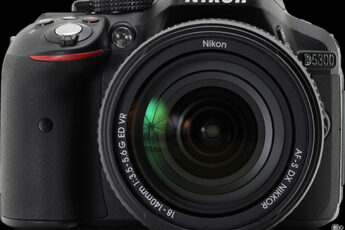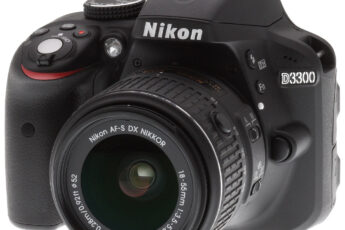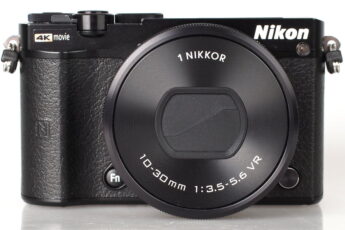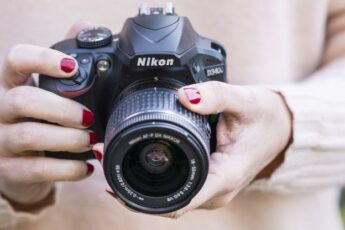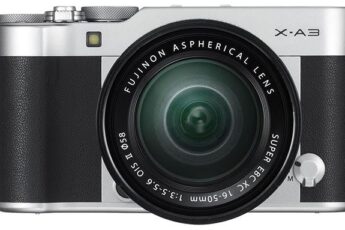Nikon is one of the two undisputed kings of the DSLR world, along with Canon. DSLR cameras are what most people think of when they think “professional photographer.” They have a system of internal mirrors that direct light from the lens to an optical viewfinder for composition. The inner mirrors create extra weight and space, and give DSLRs their familiar blocky design. Anyone interested in photography has probably seen someone walking with a Nikon DSLR. And they probably wondered just what it would be like to own one. Nikon’s lower price range DSLR cameras are well worth looking at. And the D5600 is an excellent entry point into the world of Nikon. Although slightly pricey for the beginner, it’s well designed and capable of excellent photography.
Have you read enough reviews?
- Technical Specifications
- Build Quality
- Image Quality
- What additional features does the Nikon D5600 have?
- Full Resolution with no Anti-Aliasing Filter
- Live View LCD with Touchscreen
- Videography Features
- How does the Nikon D5600 compare to the Canon EOS Rebel T6i?
- Advantages of the Nikon D5600
- Advantages of the Canon EOS Rebel T6i
- How does the Nikon D5600 compare to the Nikon D3400?
- Which photographers should consider the Nikon D5600?
- Sample Images
- Conclusion
Technical Specifications
- Price: $596.95 body-only or $646.95 with kit lens
- Kit Lens: 18-55mm AF-P DX 3.5-5.6 VR lens. “AF-P” refers to the stepping autofocus motor of the lens. DX is the sensor size the lens is meant for (Nikon APS-C). And VR means the lens has built-in Vibration Reduction to reduce photo blur from sudden motions.
- Sensor: 24.2 MP sensor (APS-C sized 23.5 x 15.6 mm)
- Number of Autofocus Points: 39 Phase detection points. Phase detection uses paired autofocus sensors that analyze light received from the subject. If the light is different between the pairs, the camera knows the focus is off and adjusts accordingly.
- Built-In Flash: Yes, with 12.0 meter (39.37 foot) range at ISO 100. Increasing the light sensitivity increases the flash detection range.
- Continuous Shooting: 5 frames per second
- ISO Range: 100-25,600
- Video Recording Capability: Full HD 1920×1080 (60, 50, 30, 25, 24 fps), HD 1280×720 (60, 50 fps)
- Image Format: JPEG and RAW. The JPEG format is a compressed format used for viewing on computers and other devices. Image data is lost in the compression but the file size is greatly reduced. RAW format contains all of the original camera image data. They are much larger than JPEGs. But for image editing and conversions to other file formats, RAW files preserve the most detail.
- Wireless Connectivity: Yes; Wi-Fi and Bluetooth. Using Nikon’s SnapBridge app, photographers can transfer images from the camera directly to smart devices. Smart devices can also be used to remote control the camera.
- Supported Memory Cards: SD, SDHC, SDXC, UHS-I
- Battery Life (CIPA Rating): 970 images per charge
- Weight: 465 g (1.03 lb / 16.40 oz)
- Dimensions: 124 x 97 x 70 mm (4.88 x 3.82 x 2.76 in)
Build Quality
The Nikon D5600 has a classic DSLR design and is built entirely out of plastic. However, it has a very sturdy and rugged quality thanks to the leather texture around the hand grip. The design is intuitive, with the mode and Exposure Control dials on top of the body. The power switch, shutter release, video recording, and exposure compensation buttons also share this space. The hot shoe unit allows the user to attach an external flash, hot shoe microphone, or other device as needed. It also comes with a fully articulating LCD screen that can flip in any direction to ensure the best composition angles.
Unlike with the kit lens of the D5500, this newer kit lens does not have a switch to disable Vibration Reduction. When using a tripod, disabling VR is a good idea to conserve battery life. It can be disabled as needed by navigating the camera menus instead.
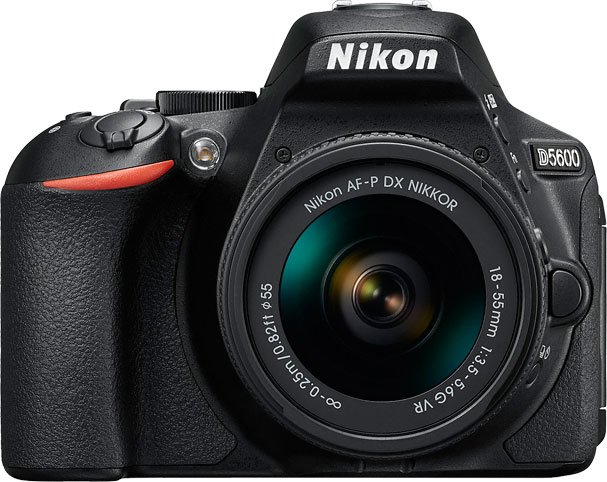
Image Quality
The D5600 comes with an APS-C sensor (sized 23.5 x 15.6 mm). Nikon’s proprietary name for them is “DX-format.” APS-C sensors are only one step below full frame sensors (sized 36 x 24 mm). As a whole, larger sensors give better control over depth of field and noise levels. Depth of field is how much of a given scene is in sharp focus. While it’s mostly dependent on the aperture setting of your lens, large sensors have an easier time creating this effect. Larger sensors also have a larger surface area for light collection. The extra light collected improves noise levels by creating more information for the camera to work with.
With 24.2 megapixels of resolution, the D5600 has an excellent megapixel count. In fact, it’s much more than the vast majority of photographers need. Each year manufacturers push megapixel counts higher to attract more customers. But for the average social media sharing hobbyist, anything over 10 megapixels is a bonus. 24 MP allows you to create 20″ x 13″ prints at up to 300 pixels per inch. If you don’t create many prints, the extra resolution gives users room for cropping without visibly losing image quality.
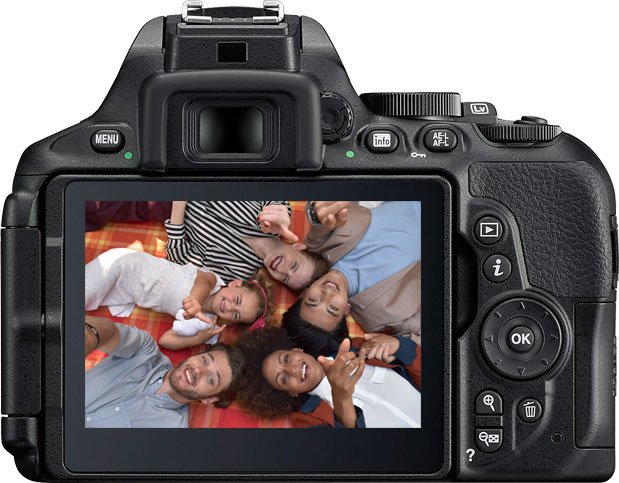
What additional features does the Nikon D5600 have?
Full Resolution with no Anti-Aliasing Filter
The , like many in the Nikon’s D series, does not have an anti-aliasing filter. Also known as low-pass filters, AA filters help reduce or eliminate moiré patterns in certain situations. Moiré are errors that can come up when photographing complex patterns like feathers or tightly woven fabric. The area will sometimes show up as slightly blurred. AA filters sit over the sensor and reduce the photo resolution slightly. If you don’t have to deal with moiré often, AA filters aren’t really helpful. The D5600 preserves the full resolution of its sensor for every picture you take.
Live View LCD with Touchscreen
Adjusting the LV switch enables Live View with the LCD screen. Live View is perfect for when you need to shoot over an obstacle like a crowd or wall. The LCD panel of the D5600 is fully articulating, allowing photographers to shoot from any angle and have a preview. The D5600 also has a touchscreen that allows one to select autofocus points directly and activate the shutter. The camera uses Contrast Detection while using Live View since the sensor is actively creating the display. As a result, autofocus is slightly slower in Live View due to how Contrast Detection works. Contrast detection systems have to pan in-and-out briefly to find maximum image contrast. So if you’re shooting fast moving action and need more speed, it’s better to stick to the optical viewfinder.
Videography Features
The D5600 does away entirely with SD video (640×480), which is probably for the best. Few people record at this resolution. Unfortunately, the D5600 does not have 4K video resolution (3840×2160). 4K is more and more common among intermediate priced DSLR and mirrorless cameras. However, the D5600 does have a microphone port. For the videography oriented, being able to use a separate microphone is a welcome addition.
Time lapse photography and movie modes are worth taking a look at in the D5600. Time lapse photo mode allows the user to set a time interval during which the camera will take pictures. And the movie mode stitches the pictures together into a .mov file that shows the changes over time. If you want to have access to the individual frames, then stick to time lapse photo mode. These are great for lovers of clouds over landscapes, germinating seeds, and other long-term events.

How does the Nikon D5600 compare to the Canon EOS Rebel T6i?
These two cameras are both geared towards the higher-end beginner-intermediate market and have many of the same features. Both have APS-C 24 MP sensors. They both have a decent continuous drive speed and are backed by a major DSLR manufacturer. What differences do they bring to the table?
Advantages of the Nikon D5600
Autofocus Points: The D5600 has 39 AF points compared to 19 with the T6i. Having more AF points gives photographers more flexibility in composition style.
Battery Life: Nikon cameras tend to have great stamina, and the D5600 is no exception. At 970 shots per charge, it has double the battery life of the T6i (440 shots per charge).
Weight: The D5600 at 465 g (1.03 lb / 16.40 oz) weighs noticeably less than the T6i 555 g (1.22 lb / 19.58 oz). For day shoots where the camera will be around your neck for a long time, the D5600 will be more comfortable.
Timelapse Photography and Movie modes: The Nikon D5600 offers creative timelapse features that allow you to capture gradual changes over time. The Rebel T6i does not have either of these features.
Advantages of the Canon EOS Rebel T6i
Cross-Type Autofocus Points: Most AF points are wired to focus on lines in either the horizontal or vertical direction. Cross-type AF points can detect lines in both directions and usually sit in the center of the sensor. The T6i has 19 of these points, compared to 9 with the D5600. That gives it slightly more sensitivity in the center of the frame. That’s useful in scenes where the line orientation may give single typed points trouble.
Compatible Lenses: Both cameras have a huge collection of lenses that work with each body. The D5600 has 280 lenses available and the T6i has 292. The Rebel T6i has a slight edge here but not enough to make it significantly better than the D5600.
While both cameras have an excellent skeleton to build off of, the D5600 has some significant advantages over the T6i. It has better battery life, is lighter, and has more autofocus points to work with. The extra cross-type points and lens choices of the T6i aren’t enough to make it significantly better than the D5600. Unless you already own a large number of Canon lenses, the D5600 brings more value for your dollar.
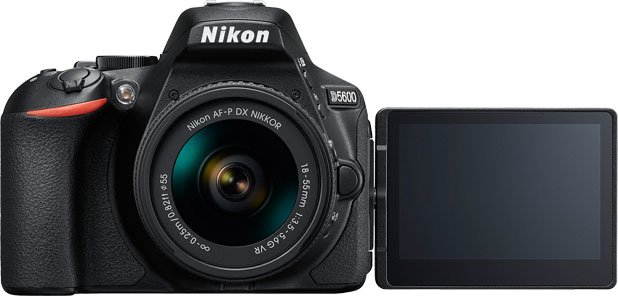
How does the Nikon D5600 compare to the Nikon D3400?
The two cameras are similar as you’d expect. The D5600 replaced the now discontinued D5500 and D5300, but it’s also the next step up from the Nikon D3400. Price-wise, the D5600 is geared towards an intermediate market at $646.95. On the other hand, the D3400 remains the beginner’s budget choice at from $440.94.
A key difference between the two is the larger number of autofocus points in the D5600. The 39 AF points gives the user much more flexibility in composition options compared to the 11 points of the D3400. The D3400 has slightly more battery life, at 1200 images per charge. But the D5600’s 970 images per charge is still excellent for a DSLR; 400-600 images per charge is much more common.
The D5600 does bring a microphone port for the videography inclined. And the wireless Snapbridge functionality is significantly improved. The D5600 can not only transfer photos remotely to smart devices, it can also be remote controlled by them. The D3400 is limited to photo sharing between devices only.
The D5600 comes with a fully articulating touchscreen LCD screen whereas the screen of the D3400 is fixed and not touchscreen. It is overall a decent upgrade over the D3400. But many other base statistics, such as the sensor and dimensions, are still similar in most respects. The D3400 remains a very competitive choice for the budget-minded.

Which photographers should consider the Nikon D5600?
The D5600 is a fantastic choice for beginner photographers who feel confident in their ability to learn the ropes of DSLR photography. The D3400 has a slightly simpler design and menus that explain much more. But the D5600 brings better functionality for the higher price while still being a fairly basic DSLR. Intermediate photographers won’t find that the D5600 offers much more than a beginner level DSLR. They are better off considering the D7200 instead. The D5600 is an excellent generalist camera. It has a respectable 5 fps continuous drive speed and large APS-C sized sensor with 24.2 MP of resolution. Paired with the right lens choice, the D5600 can take excellent photos across most photography genres.
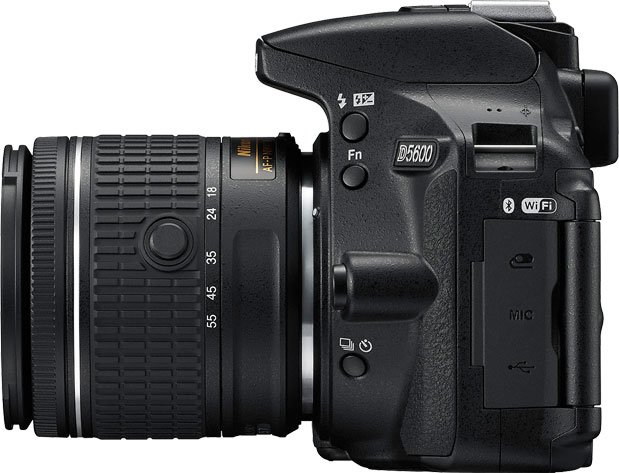
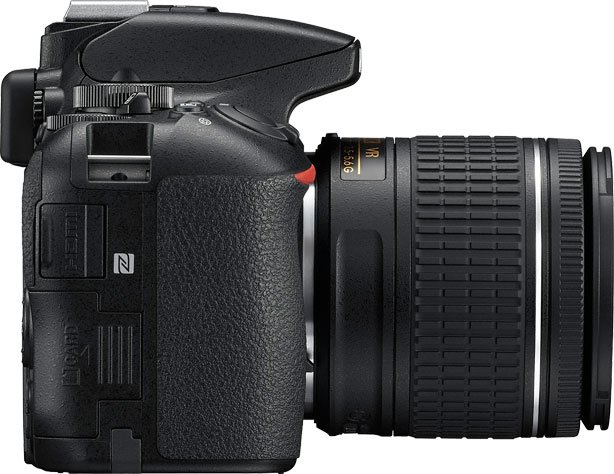
Sample Images
Conclusion
Overall the D5600 is a well-rounded camera but $596.95 feels slightly overpriced for what it has to offer. It’s a modest upgrade from both the D5500 and D3400. Its key features include amazing battery life and a relatively large sensor compared to compact and mirrorless cameras. Image quality is great across the board assuming you’ve purchased lenses to complement a given photography style. And Nikon is an excellent brand to build a lens collection around. With 280 lenses compatible with the D5600, you’ll never run out of options. And with prices lower than ever, it’s a great camera to consider if you’re new to the DSLR world.



















